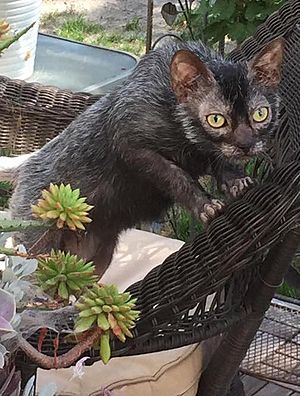Lykoi facts for kids
Quick facts for kids Lykoi |
|
|---|---|
 |
|
| Common nicknames | Werewolf cat, wolf cat |
| Origin | United States |
| Breed standards | |
| TICA | standard |
| Domestic cat (Felis catus) | |
The Lykoi is a special type of cat. It has a unique look because of a natural change, called a mutation, in its genes. This makes it look a bit like the popular idea of a werewolf. This natural change has happened in regular house cats over the past 20 years. Scientists have checked their DNA to make sure they are different from Sphynx or Devon Rex cats. The Lykoi breed was first developed in Vonore, Tennessee. The name "Lykoi" comes from the Greek word for 'wolves'.
Contents
What Makes Lykoi Cats Special?
Lykoi cats can have different amounts of hair. Some are almost fully covered, while others have less fur. Sometimes, they might even lose almost all their hair. When this happens, they can look a lot like a Sphynx. But don't worry, their hair usually grows back!
Their fur is very unique. It can look a bit like an opossum's coat when they have a lot of hair. The best Lykoi cats have a solid black coat with a mix of white hairs, which is called a "roan" color. They also have a head shaped like a wedge and a lean, strong body.
Lykoi cats are known for being very friendly. They are usually calm and loving towards their owners. A cool thing about Lykoi cats is that they shed a lot of hair when they get older. But then, depending on the season, their hair grows back. The missing fur around their face gives them their famous werewolf-like look.
How the Lykoi Cat Breed Started
The Lykoi breed started with two different groups of regular house cats. These cats had the special Lykoi gene. The first group was found in Virginia in 2010 by Patti Thomas. She helped create and name the breed. In 2011, Johnny Gobble found a second group of these cats in Tennessee.
The Lykoi breed was shown to The International Cat Association (TICA) in 2012. TICA is a big group that recognizes cat breeds. Everyone agreed to give the Lykoi "Registration Only" status. This meant they could be officially registered.
By May 2017, the Lykoi became a "Championship Breed" with TICA. This means they can now compete in cat shows against other well-known breeds. People are still working to help the breed grow and become more common.
The Lykoi gene appeared naturally in wild cat groups. The Lykoi breed was officially started in 2011. Johnny Gobble, Brittney Gobble, and Patti Thomas worked together. They found two groups of kittens that were not related but looked very unique. The Gobbles carefully checked the cats' health. They wanted to make sure their unusual look was not caused by any sickness.
To prove that the look came from a gene, Johnny Gobble bred two of the unrelated Lykoi cats. This was the first time Lykoi cats were bred on purpose. Since one of the mother cats was a black house cat, they started breeding Lykoi with black house cats. This helped to make the breed stronger and healthier. They found out that the Lykoi gene was "recessive." This means both parents need to carry the gene for the kittens to show it. More breeding with black house cats was done to keep the gene pool wide. Sometimes, Lykoi cats are still born in the wild. These cats can sometimes join the breeding program. This helps make sure the breed stays healthy and has enough different genes.
Why Lykoi Cats Have Unique Fur
Scientists at the University of Tennessee looked closely at Lykoi cats' skin. They took small samples of skin to study them. The scientists could not find any problems with their skin that would explain their unique fur pattern.
What they did find was interesting. Some of the hair follicles (the tiny pockets in the skin where hair grows) did not have all the parts needed to make hair. This is why Lykoi cats don't have a soft undercoat. They also found that the follicles that could make hair didn't have the right balance of parts to keep the hair growing. This is why Lykoi cats shed a lot and can sometimes become almost completely bald. Scientists confirmed through breeding tests that this unique fur is indeed a natural genetic change.
See also
 In Spanish: Lykoi para niños
In Spanish: Lykoi para niños

